ARCHITECTURAL

























Learn what to expect in this issue as we bring you fresh stories from across the Triangle and share new features to expect in 2023. �4
National award-winning architecture firm Pursley Dixon gives us inside access to one of Blowing Rock’s most stunning properties with views of the Pisgah National Forest that match. While understanding more about this mountain retreat, gain a new-found appreciation for the firm’s simple belief that beauty matters.

26 �8
�2 32
Landscape architect Jeff Allen opens up about designers who have shaped and inspired his work and how we can learn from those who have come before us.

Columnist Lisa Johnson shows us how to set a table that steals the show with place settings guaranteed to impress your guests.
Palm Springs, California is known as a haven for mid-century modern design. We take you there to tour Hi-Sun, one of the city’s stunning vintage homes on display during the annual Modernism Week celebration.
Cynthia Hill invites readers into her nontraditional journey of how being a successful pharmacist led to becoming an Emmy-award-winning filmmaker. She opens up about her storytelling process and how her North Carolina roots continue to shape her work.

Betsy Bardi shares some of her go-to tips that can elevate your home. She incorporates pieces that she and her team custom designed with the manufacturer.


38
At the helm of Raleigh’s largest community of visual artists under one roof, Carly Jones explains how Artspace is creating access and increasing its reach. Her background as a talented performing artist informs her role as CEO, and Carly’s enthusiasm and vision are exciting. 46

36 44 40
Scott Levitan, CEO of the Research Triangle Foundation, connects RTP’s past with its future. He offers an insightful look at where the opportunities lie and how his team’s strategy could affect the entire region and become a model for others around the country.
Good design and a good cause — now that’s a win-win! Join us in Chapel Hill as we shine the spotlight on the inaugural Design Matters event that featured internationally recognized interior designer Shelley Johnstone. Proceeds from the event benefited The Fitch Family Comprehensive Pediatric Rehabilitation Program at UNC Children’s Hospital.
National Book Award-winning writer and North Carolinian Jason Mott explains the inspiration behind his celebrated novel, Hell of a Book. And he shares how traveling the country helped him understand the Black experience in America.

Hello, #marvelouslyMOD readers! I’m delighted to share this latest MOD Society issue with you.

We unveil a new feature showcasing homes and work from some of the biggest names in the country. In this issue, I am thrilled to give you an inside peek at a truly unique Blowing Rock retreat with jaw-dropping views designed by Pursley Dixon Architecture. Prepare to be wow-ed!
We also bring Modernism Week home to you as we tour one of Palm Springs, California’s most impressive mid-century modern homes.
Next, we introduce you to three change-makers from across the Triangle. Cynthia Hill, Carly Jones and Scott Levitan are passionate, bold leaders in their respective fields who make a real difference in their communities and also inspire change more broadly.
Cynthia Hill is an Emmy-award-winning filmmaker with an untraditional background. She reveals how she stays true to herself and has arrived at where she is today by telling stories that matter.
Raleigh native Carly Jones takes us inside her vision as the leader of Artspace, a community mainstay where she once attended art classes as a youth.
North Carolina was recently named “State of the Year” for economic development. Scott Levitan shares insight from Research Triangle Park, providing context on the history that led to this moment and a vision for how the Triangle can plan in distinct ways for the future.
We chat with National Book Award winner Jason Mott in this month’s Book Club feature. Jason opens up about his raw, revealing novel, Hell of a Book Points of View columnist Lisa Johnson sets the table for you and offers helpful tips and curated selections for tableware.
Landscape architect Jeff Allen opens up about designers who have shaped and inspired his work and how we can learn from those who have come before us.
In Society Sightings, we shine the spotlight on Design Matters, an event that brought together interior and floral designers, as well as artists from across the state to raise money for The Fitch Family Comprehensive Pediatric Rehabilitation Program at UNC Children’s Hospital. Internationally recognized interior designer Shelley Johnstone served as the keynote speaker.
I think you’ll enjoy what we have in store this year. I look forward to being encouraged alongside you as we share delightful stories from across the Triangle and beautiful inspiration from around the country.
See you in the spring!
Meredith Martindale, editor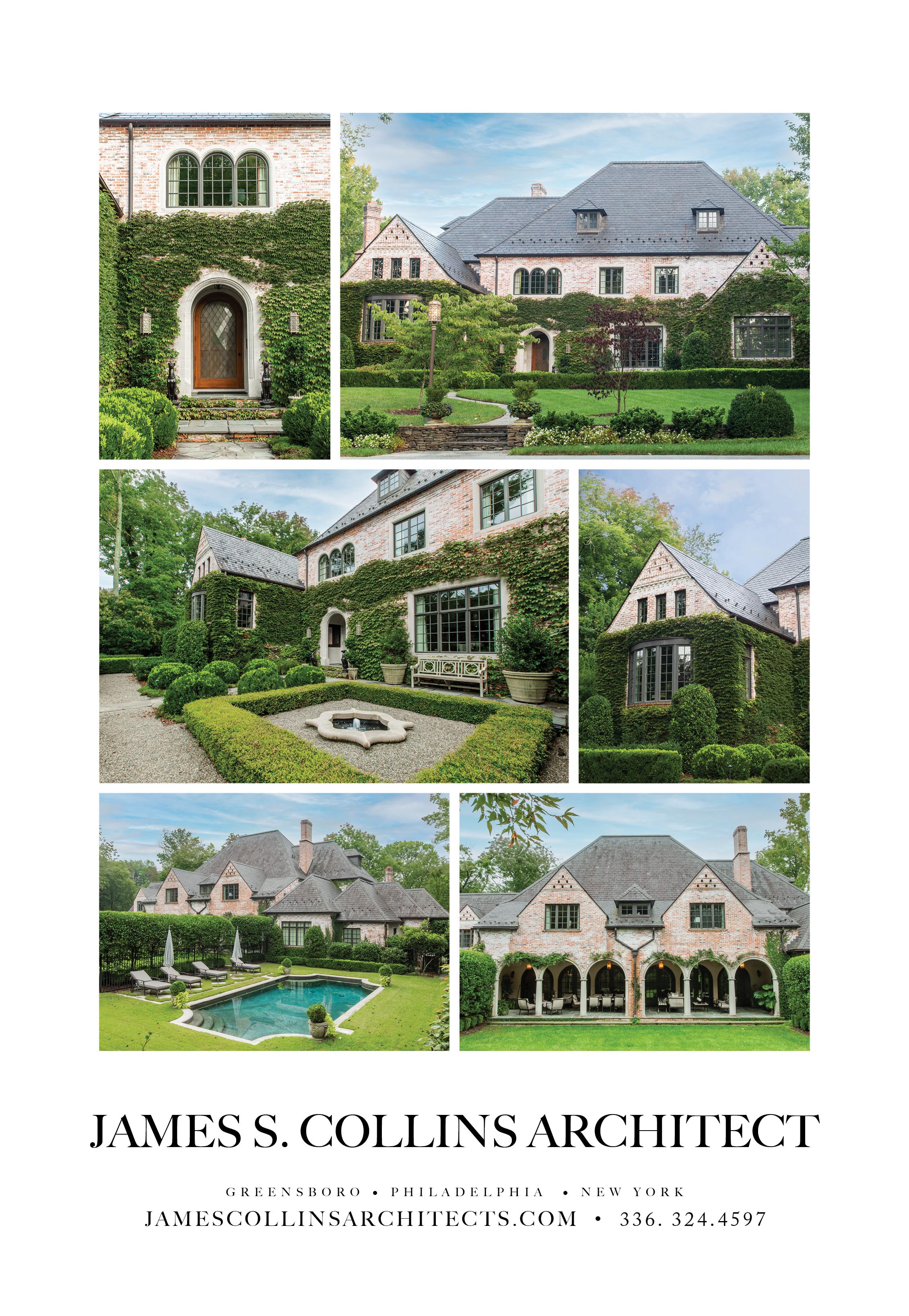




Charlotte-based Ken Pursley and Craig Dixon have known each other since attending architecture school at Auburn University together. They worked together for many years under the Pursley Architecture name before Craig became a partner and the firm evolved to become Pursley Dixon Architecture in 2012. For Ken and Craig, design and architecture have always been a part of their lives. Ken grew up building model trains in his basement and took a drafting class in high school, solidifying his interest in design. Craig grew up in the rural South and spent most of his time outdoors, building treehouses and forts when he wasn’t joining his father, a builder, on job sites.
Today, Pursley Dixon custom homes reflect each client while bringing together classicism, modernism and surprising, detail-filled elements from top to bottom.


A Blowing Rock getaway for a repeat client is no exception. Sophisticated and well-traveled, the couple did not want a predictable, rustic mountain cottage but instead desired a welcoming place to host family and friends that reflected the beauty all around them. The couple chose to tear down an existing property tucked in the forest on the site. The original home provided Pursley Dixon with a model for what they could achieve and helped them see how best to showcase the breathtaking views of the Pisgah National Forest.

At the first site visit, Pursley Dixon immediately recognized what would prove to be one of the project’s most significant obstacles and opportunities: an incredibly steep lot with heavy slopes and a curving driveway.
“The architecture really needed to respond to the natural element,” Ken says.
The architects used natural materials one would expect to see on the property, such as rock and wood.
“We didn’t want to introduce brick or something more man-made,” Ken says.
“As the house has mellowed, it’s had some years to start to blend in even further with the site,” Craig adds.
Pursley Dixon approached this home like a movie plot with an introduction, a series of things that happen and a loud crescendo moment.
“The view and the lot are just falling away from you forever,” Craig says. “We took that concept and created an ‘aha’ moment where you only know the view once you get inside. First, we unveil the house, and then we unveil the view.”
“The entry is like a stone cave,” Ken adds. “You go down a few stairs, and it’s intentionally very compressed. It works like a cone, opening up to the light as the architecture falls out of the way, and all you see is glass and the view.”


Pursley Dixon excels at incorporating unexpected design details, and they can be found throughout this Blowing Rock home.

“We incorporated playful, peekaboo moments throughout the home, like the dormers you see at the front of the house that are actually bringing light into the secret stairwell as well,” says Ken.
With Craig’s engineering ingenuity, the porch has no corner post to cast a full panoramic view. It reaches out into space, another intentional detail.
“The homeowner wanted to be as high up as they could to see the view, so we created drama and the experience of being lifted in the air. This only happens because of the architecture,” Ken says.
Pursley Dixon utilized a train car plan — meaning the home is one room deep — to ensure every room gets a view. In doing so, they also created opportunities for privacy amidst large communal gathering spaces.

“In the hallway, we separated the bedrooms by bathrooms and closets. Everyone can gather, but when it’s time to retreat, you have your own place,” Craig says.
“You also get an interesting series of light,” Ken adds. Continuing to create moments of connection with the natural world through surprising elements of design, Pursley Dixon designed a weather porch off the primary bathroom.
“Now the owner can step out and see what’s happening outside before she gets dressed,” Craig says.
Referencing the Roman architect Vitruvius Pollio’s three pillars of architecture — firmness, commodity and delight — Ken adds, “A home has to stand up, it has to meet the needs of the people using it, and it has to be beautiful. It’s not an option.”
“My favorite part now is watching the family live in the house,” Craig says. “Visiting them, I saw how everything we talked about was there. You could see how they lived in it, and it was amazing to watch. They’re very busy and travel a lot, but when they’re at home in Blowing Rock, they’re very relaxed.”
The architects credit the many partners it took to make this dramatic, one-of-a-kind vision come to life. Relationships built on trust with clients, the builder and vendors are critical to their success.
“We liken it to a great dinner party where everyone is at the table contributing in healthy ways,” Ken says. “The conversation is what’s unique to all those people. We don’t want someone dominating, and we don’t want to dominate the table. We want balance. When that happens, you get a wonderful conversation. You achieve a great work of architecture that’s only going to look the way it does because of the people around the table.”
Their signature style has undoubtedly caught the eye of bespoke homeowners across the country, but Pursley Dixon has also found a way to bring their homes to the masses. In late 2021, they published their first book, Finding Home. The book invites readers into 15 homes to connect emotionally with their work through imagery and narrative.
“Through the book process, we realized what defines the beauty we seek to create. It is an emotional connection to the space. It’s about creating something curated to a person that feels like an extension of themselves,” Ken says.
Ken and Craig are proud of their firm’s accomplishments and acknowledge their talented team for its success. Looking ahead, they are designing projects from Vermont to Washington State to the coast of North Carolina.
“We want to solve interesting problems for interesting people. We are lucky to have people seeking us out who want to do just that. That’s why we’re here and what makes this work fun,” Ken shares.
–Meredith Martindale, editorARCHITECT: Craig Dixon and Ken Pursley of Pursley Dixon Architecture

INTERIOR DESIGNER: Bronwyn Ford of Pursley Dixon Ford Interior Design
BUILDER: Matthews Collins of Paradigm Custom Homes
LANDSCAPE ARCHITECT: Ed Snyder and Elizabeth Weigl of Greenleaf Services, Inc.
Featured Home Photos
Cover Entry
Pages 14-15 Living Room
Page 16-17 Porch
Page 18 Kitchen
Pages 19 Bathroom
Page 20-21 Bedroom
Page 21 Hallway (top & bottom)
Page 22 Porch
ON
Pursley Dixon Architecture
PUBLISHER
MSM Media, LLC

Kathryn Field
VICE PRESIDENT OPERATIONS
Crystal Staley
EDITOR-IN-CHIEF
Jennifer Bringle
Editor@yourMODsociety.com
EDITOR
Meredith Martindale
Triangle.Editor@yourMODsociety.com
CONTRIBUTING WRITERS
Jeff Allen
Betsy Bardi
Lisa Johnson
PHOTOGRAPHERS
William Abranowicz
Anna Routh Barzin
Patrick Ketchum
Aura Marzouk
Stephen Thrift
LAYOUT AND DESIGN
Stallard Studio
DIGITAL AGENCY

The Buzz Effect
ADVERTISING
Advertising@yourMODsociety.com
CERTIFIED REFORESTED
“Study nature, love nature, stay close to nature. It will never fail you.” – Frank Lloyd Wright
A favorite quote from the famous architect resonates with me as it did with Frederick Law Olmsted, who pioneered this notion. Olmsted knew the positive effects the natural world had on people. He was inspired by the work of Lancelot ‘Capability’ Brown, the impetus and drive for his design of Central Park. During my time in New York, I combed Central Park. So many precedents and varieties of design all composed in one park. I was constantly amazed and inspired to see such wonder of a man-made living work of art teeming with vibrancy, culture, activity and wildlife. All by design.
How does this shape the work in our office? We are classical designers influenced by principles associated with harmony and restraint. We adhere to recognized standards of form and craftsmanship with formal lines, symmetry, geometry and simple planting schemes. As a young designer, I was struck by the relationship between Sir Edwin Lutyens and Gertrude Jekyll, where Lutyens provided strong architectural spaces filled with lush plantings that evoked impressionistic paintings of Claude Monet, designed by Jekyll. Their gardens created a strong relationship between the man-made and the natural landscape.
Bunny Mellon says, “Nothing should be noticed.”
I interpret this as the design should be intentional and complement, if not fit seamlessly with the architecture and the broader landscape. Subtlety is paramount, as if the design has always been a part of the broader fabric of the home, neighborhood and community. The appropriate design is intuitive and provides inspiration and calmness.
“Part of creating is understanding that there is always more to do; nothing is ever finished,” Mellon also says. I believe gardens and landscapes are ephemeral. They work at their own pace and grow in unexpected ways. How do we grow with them? What does it say about nature?
– Jeff Allen, Landscape Architect jalallc.com



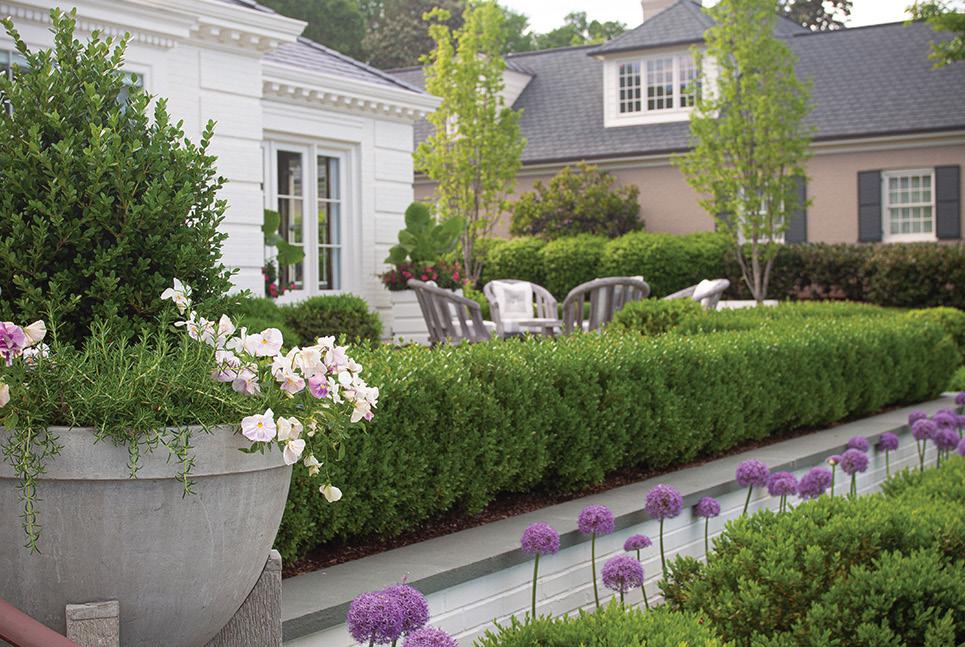

 A community garden filled with ornamental herbs and wildflowers with a rustic garden shed and birdhouse greet residents and neighbors on their daily commute.
This stone-and-brick courtyard was inspired by the work of Lutyens and Jekyll’s work at Hestercombe and Folly Farm with boxwoods and plantings in the joinery.
A line of boxwood hedging repeats the architectural form defining the terraces beyond. Pink pansies in a modern bowl add splashes of color while alliums dot behind a boxwood cloud hedging.
Simple boxwood hedging and Annabelle hydrangeas create the perfect setting for the foundation of this shingle home.
Casual seating on a bluestone terrace sits in a lush lawn surrounded by plantings of hydrangeas, boxwoods, ferns and liriope anchoring an old home.
A zinc planter with annual color and a rounded boxwood provide foreground plantings while a quiet sitting area under a dogwood awaits guests’ arrival.
A community garden filled with ornamental herbs and wildflowers with a rustic garden shed and birdhouse greet residents and neighbors on their daily commute.
This stone-and-brick courtyard was inspired by the work of Lutyens and Jekyll’s work at Hestercombe and Folly Farm with boxwoods and plantings in the joinery.
A line of boxwood hedging repeats the architectural form defining the terraces beyond. Pink pansies in a modern bowl add splashes of color while alliums dot behind a boxwood cloud hedging.
Simple boxwood hedging and Annabelle hydrangeas create the perfect setting for the foundation of this shingle home.
Casual seating on a bluestone terrace sits in a lush lawn surrounded by plantings of hydrangeas, boxwoods, ferns and liriope anchoring an old home.
A zinc planter with annual color and a rounded boxwood provide foreground plantings while a quiet sitting area under a dogwood awaits guests’ arrival.
Dinner parties are making a comeback, and there’s a return to intimate dinners. People sitting around a table sharing a meal and an experience is magical. There’s something beautiful about coming together for a dinner and a well-appointed table complete with lovely linens, china, glassware and flatware that always strengthens an elegant setting. Supporting pieces, such as chargers, napkin rings and place cards play an important role in ensuring your table will shine!

Richard
Hand-blown colored glass becomes the jewel of the table. Vintage-inspired, yet refined and modern.


Pickard green charger is paired with Pickard Nancy by Charlotte Moss, dinner plate on an octagonal two-sided placemat and lovely Corte linens, all available at The Shop on Blair. Italian stemware and bamboo flatware adds the perfect touch to this luncheon or casual dinner look.


 Ginori china from Italy shines in this beautiful place setting, and the Buccellatti sterling silver adds wonderful elegance. Lalique and vintage stemware combine for a twist on a classic.
Estelle colored stemware shows off the pattern in this lovely place setting filled with organic materials and textures. Vietri flatware is perfectly paired with the bamboo reed placemat.
PRO TIP #1
Pulling double duty — a sterling silver bud vase that also holds a pretty place card for a personal touch.
Ginori china from Italy shines in this beautiful place setting, and the Buccellatti sterling silver adds wonderful elegance. Lalique and vintage stemware combine for a twist on a classic.
Estelle colored stemware shows off the pattern in this lovely place setting filled with organic materials and textures. Vietri flatware is perfectly paired with the bamboo reed placemat.
PRO TIP #1
Pulling double duty — a sterling silver bud vase that also holds a pretty place card for a personal touch.
Christian Dior Casablanca china is paired with sterling silver-and-wood flatware and Baccarat Messina stemmed wine glasses. A Kim Seybert beaded placemat, embroidered napkins and bamboo knife holder complete this elegant setting.


A knife rest is used to hold a used knife — such a gracious way to save your beautiful linens.
Hermes Carnets d’Equateur Panther salad plate shines on this malachite dinner plate. Vintage platinum band stemware adds an interesting and complementary finishing touch to this tres chic look.

Custom embroidered linens add an extra level of charm to this setting. Vintage glass dinner plate with Farahnaz by Haviland china, William
crystal and June salt dish are the perfect combination.

Lisa Johnson and Company and The Shop on Blair provides timeless design, one-of-a-kind objects and fine art blending antique and contemporary style to create lovely and interesting spaces. lisajohnsonco
 Yeoward
Yeoward


Nestled amid rugged peaks in California’s Sonoran Desert, Palm Springs exudes a chic sophistication that feels of another era. That’s probably because the city is home to one of America’s best-preserved concentrations of mid-century modern architecture.

During the era between the 1940s and 1970s, some of the nation’s most talented young architects came to Palm Springs, interpreting the sleek design style of the day with a twist that came to be known as “desert modernism.” This interpretation took the clean, minimalist lines mid-century modern style is known for and tweaked the look to accommodate an indoor/outdoor lifestyle. In desert modernism, rooflines are often flat or butterfly-wing v-shaped, and floor plans are open with plenty of windows and sliding glass doors that flood the home with natural light.
 photo by patrick ketchum
photo by patrick ketchum
One of the most beautiful examples of this style is the home known as Hi-Sun. Designed by Charles Du Bois and built by the Alexander Construction Company in 1963 as the model home for the Las Palmas neighborhood’s Summit Estates development, the home is now the personal residence of Kevin Kemper and Howard Hawkes of H3K Home+Design.
Kevin and Howard renovated the home to reflect their personal style while preserving the home’s Hawaiian flair and other original mid-century modern features such as the stone fireplace in the living room. The designers added new surfaces and refreshes throughout interior

and exterior areas of the four-bedroom, three-bath home and resort-like poolside area, complete with outdoor kitchen. Modernism Week sponsors Bang & Olufsen, Brizo, California Closets, Dunn-Edwards, Ferguson Bath, Kitchen & Lighting Gallery, Flor, JennAir and Willis contributed to this project.
Hi-Sun will be among a spate of homes open to the public for tours during Palm Springs’ Modernism Week, Feb. 1626, 2023. For more details about Modernism Week and other homes on display, visit modernismweek.com.
– Jennifer Bringle, editor-in-chiefThough Cynthia Hill was always creative, a childhood art teacher in her hometown of Pink Hill, North Carolina, told Cynthia she could never be an artist because she was too much of a perfectionist. That advice led Cynthia to pursue math and science, ultimately landing an advanced degree as a pharmacist.
While studying at UNC-Chapel Hill, Cynthia had a chance encounter with filmmakers from Los Angeles, planting the seed for an interest, passion and talent that would later land her multiple Emmy awards. She started pursuing this passion while still a pharmacy student.
“I stopped writing papers,” Cynthia says. “Every project I had to do for pharmacy school, I made a video instead.”
In graduate school at Auburn for pharmacy administration, Cynthia took advantage of a production studio on campus, where she started making films.
“I thought maybe I would do health education media,” she says. “But I had more stories in me that I wanted to tell. It took me a long time to call myself an artist or a filmmaker, though.”
Hanging next to various film awards is her 10-year service certificate from the Walmart pharmacy. Cynthia appreciated her work as a pharmacist and understands how it provided unusual ways to develop as a filmmaker.
“Having that kind of security allowed me to take risks in other aspects of my life, in filmmaking, in real estate or in whatever else I was trying to do — working at the drugstore, I made enough to not worry about money,” she says.
“It also allowed me the freedom to make films without making content for other people. I never worked for anyone else. I figured filmmaking out on my own. In hindsight, it was a very strategic way to approach it,” she adds.
Cynthia moved to New York City to continue her film career, but then started traveling back to North Carolina for frequent work on her documentary, “Tobacco Money Feeds My Family.”

“At the time, being in North Carolina felt like a disadvantage,” she says. “There was an assumption that I must be less talented because I’m not in New York or Los Angeles. My cheeky argument has always been that if I can make it here, I’m probably more talented since I don’t have the same resources or support.”
So, she returned permanently to North Carolina in 2001 and has called Durham home since.
“Durham seemed more progressive than other parts of the state,” she says. “It felt more like where I was living in the West Village, in the city. It felt like a community I could belong to.”
She credits local institutions like the Center for Documentary Studies and Full Frame Film Festival for contributing in meaningful ways to her professional life here. These organizations have offered the community rich opportunities to engage with the industry, providing excellent value to local filmmakers.
“You could meet Albert Maysles, Frederick Wiseman, Barbara Kopple and others because they were coming to us. The ripple effect of bringing that industry straight here does so much more than what I think most folks understand,” Cynthia says.
Cynthia has now worked with her Markay Media team for over 20 years.
“We all started green together,” she says. “We’ve learned the craft together and have quirky ways of making films and putting content together. We were left to our own devices and created our own style because we didn’t know any better. But it works.”
Calling it a vérité style, Cynthia shoots in a way where she waits for moments to happen.
There were initial naysayers with “A Chef’s Life,” the PBS series focused on Kinston chef Vivian Howard that Cynthia calls a “hybrid food show, documentary and reality show all in one.”
“We instinctively made something that we thought was interesting, that we would watch, that shared the issues important to us, and that was entertaining,” she says. “It worked. It resonated. But at first, no one knew how to label it, so they didn’t think it would be successful.”
But the show became a huge success, running for five seasons on PBS, earning multiple awards, including two Emmys, and putting Howard and her farm-to-table cooking on the national culinary map.
“Being told ‘no’ just means I haven’t asked the right question yet,” Cynthia said. “With ‘A Chef’s Life,’ I knew the audience could understand it even if it wasn’t just a ‘stand-and-stir’ cooking show.”
While her documentaries and shows usually tell the stories of others, Cynthia’s work is also deeply personal.
“I joke that a lot of my work is autobiographical in disguise,” she says. “It has a lot to do with what I’m dealing with or my interests. I don’t want to be on the screen, so I hide behind it, but I’m always exploring what’s important to me.”
It seems the film industry has evolved since the beginning of Cynthia’s career when she felt pressure to establish herself in New York or Los Angeles.
“I appreciate that there is a push now for filmmakers to tell their own stories from their community. I think it’s important to feel like you can be wherever you want. There are exciting stories to tell right in your own backyard,” Cynthia adds.
In charting her path, Cynthia has found great success and stayed true to herself.
“I hope my daughters can see me as someone who tackles life in a slightly different manner that really works,” she says.
– Meredith Martindale, editor“Even if it’s an issue-oriented project, it’s always still character-based, and we’re always waiting for moments that tell us something deeper than a traditional interviewbased approach,” she says. “We like to let the story go where it needs to go and not force it.”
“The beauty of this work is that I get to dive deep into one world and then the next world. It’s something I never could have imagined...”

A modern take on a sunburst mirror infuses warmth and sparkle into any space!

This family room sofa offers it all — comfort, customization and quality!

This cast-stone fireplace surround adds texture and architectural detailing.





Browse this collection of Bardi Designs’ favorite items and learn some of Betsy’s go-to tips to elevate your home. The fireplace and sofa are custom designed by Betsy, her team and the manufacturer.
Pillows can add color and style to any sofa.

 Betsy Bardi
Betsy Bardi
Wallpaper murals add a graphic element that helps to tell the design story.



Accessories complete the design! This bonsai sculpture is a coffee table favorite as well as the peacock colored iridescent vases to add some sparkle!
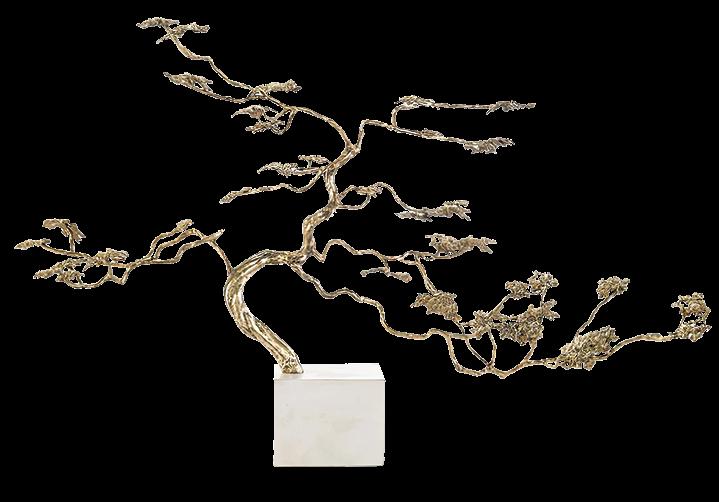
Chandeliers without exposed bulbs offer a soft, diffused light glow!


Artistic sideboards offer storage and design flair.

Large scale wall aconces add drama and a lovely glow of light to the wall.

Hammered metal side chairs add texture and softness.

Unique shapes for ottomons help to move the eye throughout the room.





Raleigh native Carly Jones attended summer camp at Artspace as a child. Her journey has come full circle as she now leads the organization as it approaches its fourth decade as a local mainstay.
“I was raised by two public servants,” Carly says. “Growing up, my mom was a teacher, and my dad served as a judge. They were great about making sure I had a very cultural upbringing, which drew me to art at a young age.”
In addition to serving as CEO of Artspace — the largest community of visual artists under one roof in the state, offering exhibitions, education and more — Carly is also a talented performing artist who studied at Miami University of Ohio on a music scholarship. She plans to participate in a couple of shows with local theater and opera companies this year.
“I appreciate that in our more modern society, there is more room for multi-hyphenates and dual careers,” she says.
As Artspace’s leader, Carly has the opportunity to build relationships with an array of people interested in the arts.
“I love that most of my job is connecting with people — artists, families, donors, stakeholders and the community,” she says.
Carly believes art can be a valuable tool for bringing people together, and that idea informs her work to make the arts accessible to all.
“Art is such a powerful tool for connecting,” she says. “But many times, it has historically been exclusive in multiple ways. Making sure the arts can get to every community, no matter their zipcode, cultural background or age group — that has been our goal here.”
Carly has worked with artists and patrons to not only diversify the audience Artspace serves, but also the people who work there, as well.
“Unless our staff reflects the communities we’re trying to serve, we can’t do all we can for those people,” she says. Now that our staff reflects the diversity of communities we serve, it is easier to build authentic relationships and broaden our reach.
“Thanks to a private donor, we just launched a new initiative for a Historically Black Colleges and Universities residency. We are also experimenting with getting outside our building and taking art out into the community. We have a new program held at Dorothea Dix Park and are partnering with Boys and Girls Clubs to reach youth who can’t get to us at Artspace.”
Carly and her team are also pursuing new ways to activate exhibits.
“It’s one thing to have a beautifully curated exhibition,” she says. “That’s something we do very well and will continue to do. What happens once it’s up, once art is on the walls? By bringing in poetry, dance, and music to complement the exhibition, we are amplifying the artists’ visions and how people can connect with their work.”
Carly points to a recent exhibition, “Corrientes Latinas,” as an example. Created by a group of local artists called the Inter-Latin American Artists Collaborative, the opening night featured cultural dancers, food and a film.
“It brought in communities who had never been to Artspace,” she says. “It’s important to see yourself represented on gallery walls and your culture reflected for people to feel welcome and celebrated. This exhibition was exactly that kind of celebration. It was beautiful.”
While she has an effervescent and welcoming spirit, Carly takes her roles as an artist and arts administrator seriously. In a rapidly growing city like Raleigh, Carly is aware of the potential impact her organization can have amidst the change and growth. She doesn’t back down from it — it excites her.
“It’s a responsibility to stay forward-thinking and push the community forward while being a place that is open for all people to connect,” she says.
“Artspace is a creative home and a place for people to be inspired, go on a date or bring their kids. To have artists in the middle of one of the fastest growing cities in the country is powerful and such an advantage for our city.”
–Meredith Martindale, editorThat means a lot, considering Scott’s extensive background in developing research parks and innovation districts. His professional work over the past 30 years has shaped communities in transformational ways, most notably in East Baltimore and Georgia Tech’s Technology Square.
Now at the helm of the Research Triangle Foundation, the steward and managing organization of the Research Triangle Park (RTP), Scott and his team have a bold vision for the region and how RTP can play a
“We have some resources at RTP that really will allow us to think out of the box and to think differently about how we compare to other regions,” Scott says.
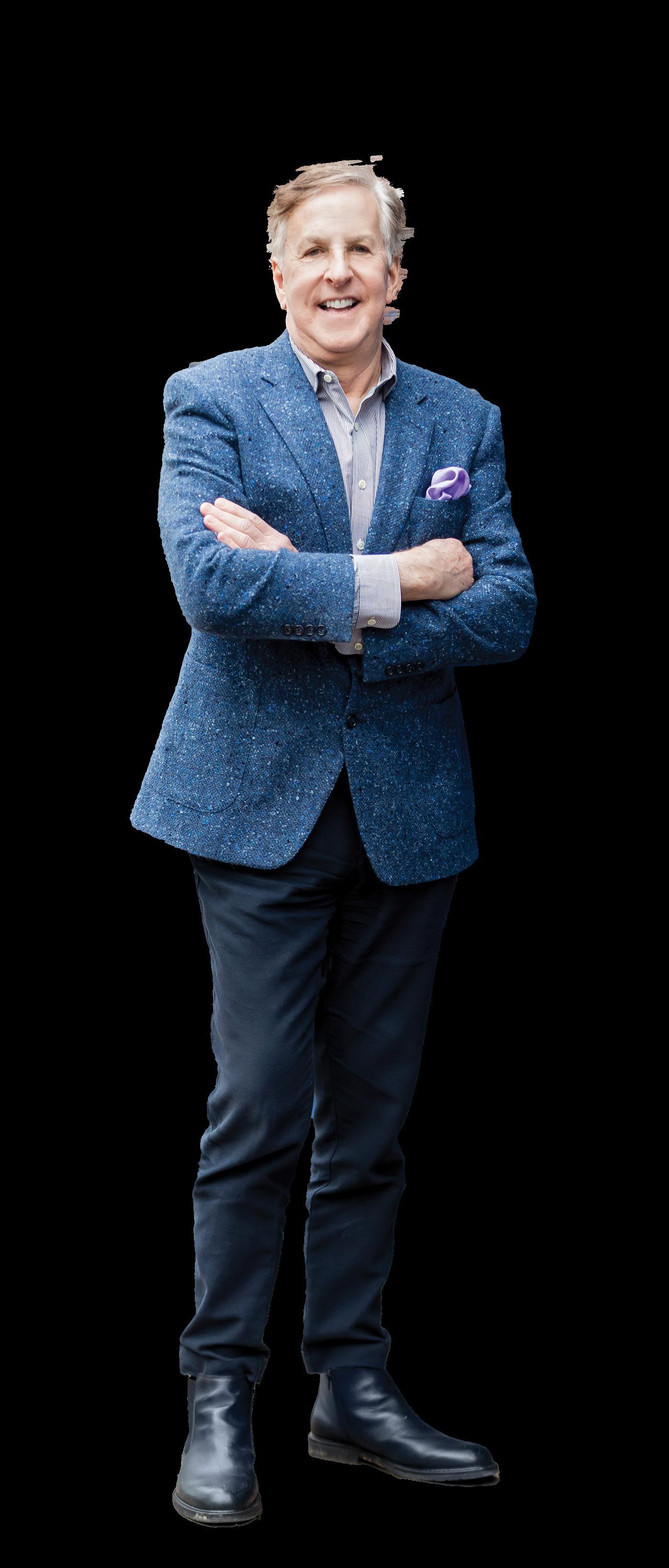
“This is one of the most exciting projects I’ve ever been a part of,” says Scott Levitan, president and CEO of the Research Triangle Foundation.
The first success story from Scott’s tenure to date at RTP is the Frontier, an innovation community created out of an old IBM campus. It offers free coworking and programming as well as office and lab space. The Frontier has blossomed into what he now calls the “financial backbone that allows the Research Triangle Foundation to be able to do what we’re doing.” Today, roughly half of the companies in RTP are based out of the Frontier campus. Next came Boxyard at RTP, a community of entrepreneurs, artists and creatives with gathering space created from shipping containers. The Foundation invested heavily in programming at Boxyard, similar to Frontier.
“Just because you build a place — buildings, offices, labs — does not mean that it’s a place you want to go. We created reasons to want to go to Boxyard,” Scott adds.
Located in the middle of the Triangle, RTP has broadened its reach from once solely a destination for work to become something much larger. Scott acknowledges how the region offers distinct communities that come together to form the Triangle. He sees it as an advantage.
“Living in the Triangle gives you many options with regard to how you want to live. You can live on a farm or in an urban setting and still be in the Triangle,” he says. “So being able to meet your friends in the middle is a really good thing. We’re not all Raleigh people, we’re not all Durham people, and we’re not all Cary people. Now we have a place to hang out during the day and after work, and Boxyard is busy on the weekends.”
The Boxyard beta project has influenced new initiatives. HUB RTP and Horseshoe at HUB are both under development. Once completed, the HUB will be a place where people can work, live, eat and play with the Horseshoe serving as a “town center” with mixed-use office and retail space.
In addition to these developments, Scott and his team are asking hard questions and looking strategically at how RTP can help shape the region’s future. Learning from Austin, Seattle and elsewhere, they are crafting a strategy that Scott hopes to unveil in early 2024.
“We hope it might help the region differentiate its future from other high growth regions that have experienced a fast expansion,” Scott shares.
The strategy focuses on equitable housing, sustainability and transit. Projections anticipate the Triangle will double in size by 2045. According to Scott, more needs to be built to meet the demand, so he is encouraging a regional dialogue and approach.
“Nobody is living in RTP right now. Some of the issues facing other communities — gentrification, displacement and neighborhood stability — can be ameliorated with thoughtful new development,” he says. “If we find a way to develop a significant amount of housing in RTP, and if rezoned and repurposed correctly, there are some real benefits that we’re learning could accrue to the residents and communities in the Triangle.”
Scott believes RTP can potentially be a model for sustainability in the country.
“You don’t always notice it, but we have watersheds running through the region. They run through RTP,” he says. “We can better utilize that land — not just for a single purpose to move stormwater to Jordan Lake — but also to become a recreational network. We have the start of it in RTP, but future planning would enhance it.”
Lastly, the Foundation’s strategy is exploring what transportation could look like in the region.
“We are exploring how development in RTP can be transit-oriented to help push things forward — rail, bus rapid transit, smart expressways or even smart streets,” Scott says. “If you can have an affordable dwelling unit served by good public transportation, then a family only needs one car, not two. It becomes a double benefit. So we think there’s a real opportunity in RTP to get engaged in that regional conversation about transportation.”
Applying the unique elements of RTP to a future-focused vision of the broader Triangle region is a risk Scott Levitan is willing to take.
“Fortune has always smiled on RTP,” Scott says.
–Meredith Martindale, editor
“Fortune has always smiled on RTP,” Scott says.


Design Matters is a series of events celebrating design, art, and architecture by presenting experts in these fields who will educate, entertain and help raise funds for important causes. The inaugural program took place on Monday, October 17, 2022, at The Carolina Inn in Chapel Hill. The program featured a presentation by internationally recognized interior designer Shelley Johnstone, moderated by her friend and style director of Frederic Magazine, Tori Mellott.
A plated lunch for nearly 150 followed their delightful conversation, and then guests enjoyed a meet-and-greet
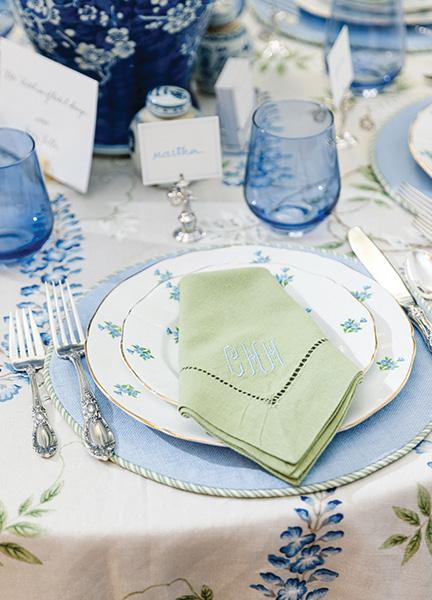




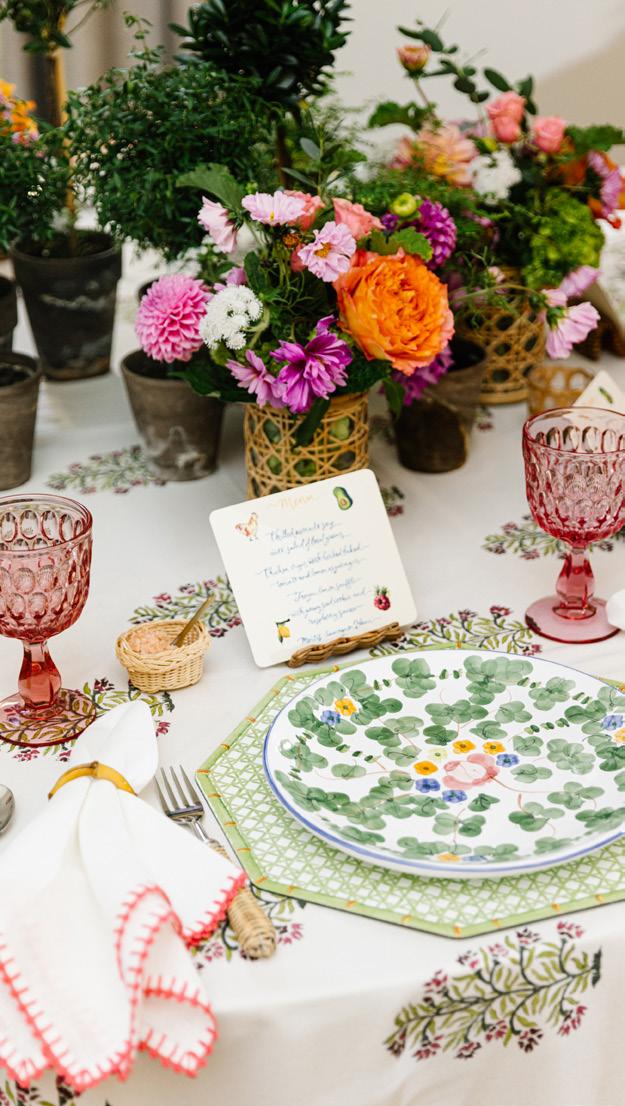
with Shelley to have their copy of her new book, A Loving Table, signed. The afternoon companion event, Set the Table, welcomed nearly 200 additional visitors, who were also able to meet Shelley for a book signing while also viewing inspirational tabletops created by interior and floral designers from across the state and accented by artwork available for purchase.
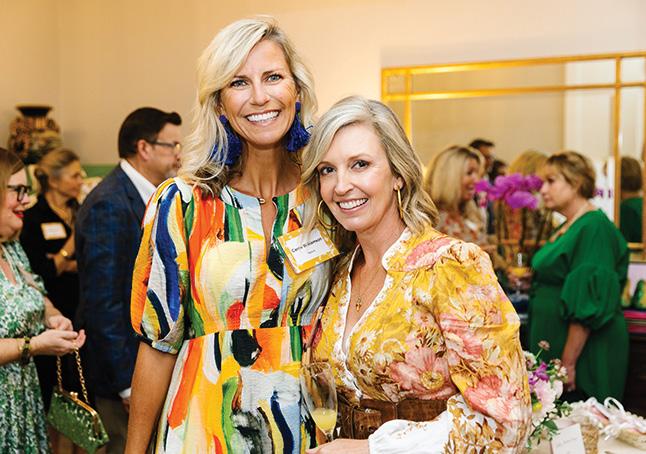
This successful initiative raised more than $85,000 for The Fitch Family Comprehensive Pediatric Rehabilitation Program at UNC Children’s Hospital.

 By
By
By
By
By The Curated Table
Hope Carmichael, Carol Hallowell, Cassidy Bayliff & Emily Sumner Carrie Williamson & Meredith Fitch
Tori Mellott, Shelley Johnstone & Sandi Rupprecht
Kara Cox Interiors
Kate Hutchison of kate.h.design
Shelley Johnstone Design
Shelley Johnstone & Tori Mellott
Anna Applegate Interiors
By
By
By
By
By The Curated Table
Hope Carmichael, Carol Hallowell, Cassidy Bayliff & Emily Sumner Carrie Williamson & Meredith Fitch
Tori Mellott, Shelley Johnstone & Sandi Rupprecht
Kara Cox Interiors
Kate Hutchison of kate.h.design
Shelley Johnstone Design
Shelley Johnstone & Tori Mellott
Anna Applegate Interiors










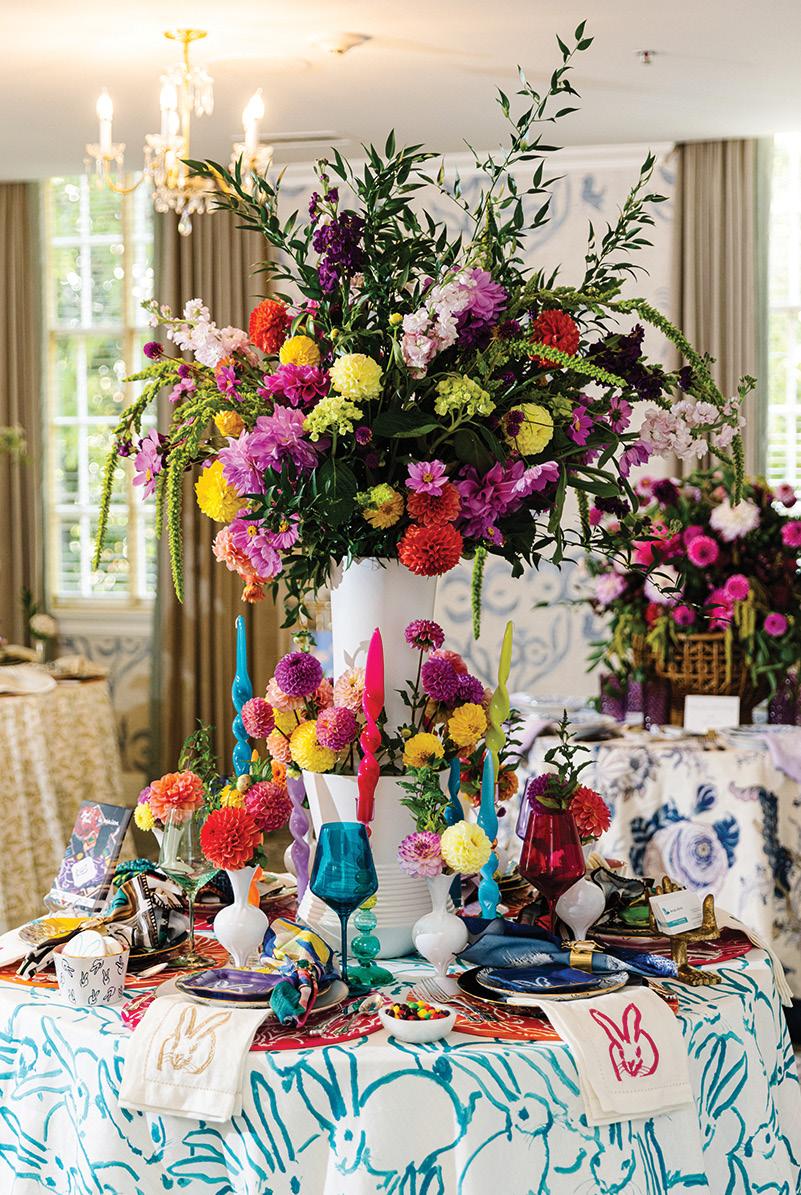

 Kate Hutchison, Eleanor Scott Davis, Anna Applegate, Maggie Dillon & Maury Poole
By Christina Spillars Meadows of Quintessentials
Kara Cox, Maggie Dillon & Kate Hutchison
Debra Zinn,Cheryl Allen & Cristina Heilig
Charlotte Camp Smith, Julia Mullen, Betty Nelson, Susan Matthews & Jackie Craig
Barbara Smith, Laura Montross & Kaye Leonard
Heather Asebes, Christina Dickson & Christina Spillars Meadows
By Lindsay Speace Interior Design
By Maggie Dillon Interiors
By Martha Schneider of La Maison Raleigh
By Christina Dickson of The Headless Hostess
Michelle Silvis, Rachel LaCkore, Liz Goldberg & Hannah Hoisington
Kate Hutchison, Eleanor Scott Davis, Anna Applegate, Maggie Dillon & Maury Poole
By Christina Spillars Meadows of Quintessentials
Kara Cox, Maggie Dillon & Kate Hutchison
Debra Zinn,Cheryl Allen & Cristina Heilig
Charlotte Camp Smith, Julia Mullen, Betty Nelson, Susan Matthews & Jackie Craig
Barbara Smith, Laura Montross & Kaye Leonard
Heather Asebes, Christina Dickson & Christina Spillars Meadows
By Lindsay Speace Interior Design
By Maggie Dillon Interiors
By Martha Schneider of La Maison Raleigh
By Christina Dickson of The Headless Hostess
Michelle Silvis, Rachel LaCkore, Liz Goldberg & Hannah Hoisington


Before he published his first novel, before that book was adapted into a television show, before he won the National Book Award, Jason Mott was simply a kid who loved reading.
Growing up in eastern North Carolina, Jason fell in love with books at a young age thanks to a mother who prioritized reading. At age 14, he read Grendel, a novel written by John Gardner from the perspective of the monster from the epic, Beowulf. The book did more than simply entertain teenage Jason — it made him realize his true calling.
“It was really powerful, and one of those life-changing moments,” he says. “When I finished reading it, the first thought I had was, ‘This is amazing, and I would love to make someone else feel the way I’m feeling right now. I think I want to be a writer.’”
Jason graduated from UNC Wilmington with a bachelor’s degree in fiction and a master’s in poetry. While he worked a day job at Verizon, he wrote in his spare time, eventually completing his debut novel, The Returned, which was published in 2013. Shortly thereafter, the book was adapted into the ABC television series Resurrection, which aired from 2014-2015.
And while that success allowed him to pursue writing full-time, Jason says having his debut become such a hit came with a range of sometimes unexpected emotions.
“You have this image of having the big book that does well and finds a home, and you just connect with it — that’s really what it’s about,” he says. “I had all of that happen very suddenly. But it was also very frenetic and kind of overwhelming. I think people fail to explain just how much comes with that type of success.”
Jason followed The Returned with The Wonder of All Things in 2014 and The Crossing in 2018. As he approached writing his fourth novel, Jason tapped into some of the emotions he felt after his debut, along with experiences from his book tour.
“I went on a book tour and was on the road for months and months and months,” he says. “It was a very busy, frenetic, overwhelming experience. But also funny and strange, and I knew I wanted to write a story about an author on a book tour.”
He pitched the idea to his agent and editor, both of whom passed. Though discouraged, Jason still felt determined to see this idea through. He found the inspiration to make the book work after the death of Freddie Gray at the hands of Baltimore police officers. Through conversations with a friend living in Baltimore during the protests following Gray’s death, Jason saw a way to weave the narratives of being a writer with being a Black man in America.
“That eventually evolved into this discussion with both of us talking about our lives as Black men in America, and all the things that came along with that, chronicling a lifetime of worries and fears and anxieties,” Jason says. “Eventually, I just decided to mix together all those thoughts on the Black experience with all the comedy of the book tour stuff.”
“One of the biggest takeaways is simply the notion that the American experience is not any one set thing and that the Black American experience is not any one set thing,” says Jason.
And Hell of a Book was born. The novel is told from two perspectives, one of a nameless narrator who is an author on tour and the other of a young Black boy named Soot. Soot lives in rural North Carolina and struggles with being bullied on the school bus, in part because of how he looks. “The book wants to do so much in terms of all of the different types of discussions it’s trying to have and the perspectives it wants to give credence to,” Jason says. “And for me, that particular story just worked better with the split narrative. It allowed me to create a different resonance and a different scope.”
A third character, simply known as The Kid is a possibly imaginary child who appears to the author while on his tour. Jason says this character was important to give the author someone to have difficult conversations with as he engages on what is otherwise a solitary tour.
“I wanted The Kid to be this place where the author could have certain types of conversations,” he says. “And the character of the author needed those conversations as much as The Kid needed to have them. So the two characters created a really unique dynamic and allowed both of them to seek what they were searching for.”
Hell of a Book debuted in 2021 to rave reviews and a host of awards, including the Joyce Carol Oates Prize, the Aspen Words Literary Prize and most notably, the National Book Award for Fiction. Earning such acclaim has been gratifying for Jason, and he hopes those accolades will bring more readers to this story and a better understanding of life for Black Americans.
“One of the biggest takeaways is simply the notion that the American experience is not any one set thing and that the Black American experience is not any one set thing,” he says. “I think the voice of Black America gets reduced down to the holy trifecta of stories which is the slave narrative, the civil rights narrative and the inner city coming-of-age narrative.
“Hell of a Book wants to talk about these very serious topics, these things that are very pertinent and very persistent in our culture, but at the same time to say that these things can be discussed in a different way, and they can be approached differently.”
– Jennifer Bringle, editor-in-chief



